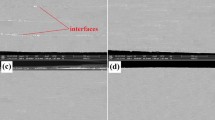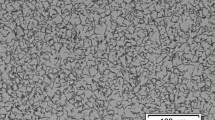Abstract
Soft magnetic materials (SMMs) are extensively used in various fields such as power generation, energy transfer and electromagnetic interference dam**. The preparation of SMMs in different forms requires expertise in diverse fabrication techniques. Furthermore, achieving optimal performance requires an understanding of the relationship between magnetic behavior and microstructure and mechanical properties of SMMs. This study focuses on analyzing the effects of accumulative roll-bonding (ARB) processing on the texture, microstructure, and magnetic properties of a commercial Permimphy alloy (Fe–80Ni–5Mo wt%). Electron BackScattered Diffraction (EBSD) analysis confirmed the expected refinement of the grain structure resulting from ARB processing, leading to a reduction in the transverse dimension of the elongated grain down to 800 nm after five cycles. The microhardness of the alloy increased by 80% compared to the as-received sample, primarily due to the refinement of the microstructure and the formation of a high density of dislocations. The findings suggest that the magnetic domain walls are more affected by low-angle boundaries rather than grain/high-angle boundaries. In addition, it was proved that subsequent annealing at 550 °C for one hour improved the alloy’s magnetic softness while maintaining the mechanical hardness achieved through ARB deformation. This improvement was attributed mainly to the removal of stresses and defects in the material without initiating the process of recrystallization.
Graphical abstract















Similar content being viewed by others
Data availability
Some data included in this work are available upon request by contact with the corresponding author.
References
Ouyang G, Chen X, Liang Y et al (2019) Review of Fe–6.5 wt%Si high silicon steel—a promising soft magnetic material for sub-kHz application. J Magn Magn Mater 481:234–250. https://doi.org/10.1016/j.jmmm.2019.02.089
Cullity BD, Graham CD (2011) Introduction to magnetic materials. Wiley
Tsuji N, Takebayashi H, Takiguchi T et al (1995) Recrystallization of solidified columnar crystals in an Fe–36%Ni austenitic alloy. Acta Metall Mater 43:755–768. https://doi.org/10.1016/0956-7151(94)00263-H
Tsuji N, Takebayashi H, Takiguchi T et al (1995) Effect of initial orientation on the cold-rolling behavior of solidified columnar crystals in an Fe–36%Ni austenitic alloy. Acta Metall Mater 43:743–754. https://doi.org/10.1016/0956-7151(94)00264-I
Tsuji N, Ito Y, Saito Y, Minamino Y (2002) Strength and ductility of ultrafine grained aluminum and iron produced by ARB and annealing. Scr Mater 47:893–899. https://doi.org/10.1016/S1359-6462(02)00282-8
Ghalehbandi SM, Malaki M, Gupta M (2019) Accumulative roll bonding—a review. Appl Sci 9:3627. https://doi.org/10.3390/app9173627
Langdon TG (2007) Ultrafine-grained materials: a personal perspective. Int J Mater Res 98:251–254. https://doi.org/10.3139/146.101473
Pfeifer F, Radeloff C (1980) Soft magnetic Ni–Fe and Co–Fe alloys—some physical and metallurgical aspects. J Magn Magn Mater 19:190–207. https://doi.org/10.1016/0304-8853(80)90592-2
Boothby OL, Bozorth RM (1947) A new magnetic material of high permeability. J Appl Phys 18:173–176. https://doi.org/10.1063/1.1697599
Bozorth RM (1953) The permalloy problem. Rev Mod Phys 25:42–48. https://doi.org/10.1103/RevModPhys.25.42
Valiev RZ, Islamgaliev RK, Alexandrov IV (2000) Bulk nanostructured materials from severe plastic deformation. Prog Mater Sci 45:103–189
Zhilyaev AP, Langdon TG (2008) Using high-pressure torsion for metal processing: fundamentals and applications. Prog Mater Sci 53:893–979. https://doi.org/10.1016/j.pmatsci.2008.03.002
Lenard JG (2013) Primer on flat rolling. Newnes
Huang JY, Zhu YT, Jiang H, Lowe TC (2001) Microstructures and dislocation configurations in nanostructured Cu processed by repetitive corrugation and straightening. Acta Mater 49:1497–1505. https://doi.org/10.1016/S1359-6454(01)00069-6
Saito Y, Tsuji N, Utsunomiya H et al (1998) Ultra-fine grained bulk aluminum produced by accumulative roll-bonding (ARB) process. Scr Mater 39:1221–1227. https://doi.org/10.1016/S1359-6462(98)00302-9
Tirsatine K, Azzeddine H, Baudin T et al (2014) Texture and microstructure evolution of Fe–Ni alloy after accumulative roll bonding. J Alloys Compd 610:352–360. https://doi.org/10.1016/j.jallcom.2014.04.173
Han L, Maccari F, Souza Filho IR et al (2022) A mechanically strong and ductile soft magnet with extremely low coercivity. Nature 608:310–316. https://doi.org/10.1038/s41586-022-04935-3
Vorhauer A, Rumpf K, Granitzer P et al (2006) Magnetic properties and microstructure of a FeCo ferritic steel after severe plastic deformation. Mater Sci Forum 503–504:299–304. https://doi.org/10.4028/www.scientific.net/MSF.503-504.299
Susan DF, Kustas AB, Kellogg RA et al (2021) The effects of annealing after equal channel angular extrusion (ECAE) on mechanical and magnetic properties of 49Fe–49Co–2V alloy. Metall Mater Trans A 52:4090–4099. https://doi.org/10.1007/s11661-021-06366-7
Stolyarov VV, Gunderov DV, Valiev RZ et al (1999) Metastable states in R2Fe14B-based alloys processed by severe plastic deformation. J Magn Magn Mater 196–197:166–168. https://doi.org/10.1016/S0304-8853(98)00705-7
Popov AG, Gaviko VS, Shchegoleva NN et al (2006) Effect of high-pressure torsion deformation and subsequent annealing on structure and magnetic properties of overquenched melt-spun Nd9Fe85B6 alloy. J Iron Steel Res Int 13:160–165. https://doi.org/10.1016/S1006-706X(08)60175-2
Bachmann F, Hielscher R, Schaeben H (2010) Texture analysis with MTEX – free and open source software toolbox. Solid State Phenom 160:63–68. https://doi.org/10.4028/www.scientific.net/SSP.160.63
Williamson GK, Hall WH (1953) X-ray line broadening from filed aluminium and wolfram. Acta Metall 1:22–31. https://doi.org/10.1016/0001-6160(53)90006-6
Roghani H, Borhani E, Shams SAA et al (2022) Effect of concurrent accumulative roll bonding (ARB) process and various heat treatment on the microstructure, texture and mechanical properties of AA1050 sheets. J Mater Res Technol 18:1295–1306. https://doi.org/10.1016/j.jmrt.2022.03.001
Li BL, Tsuji N, Kamikawa N (2006) Microstructure homogeneity in various metallic materials heavily deformed by accumulative roll-bonding. Mater Sci Eng A 423:331–342. https://doi.org/10.1016/j.msea.2006.02.028
Son H-W, Cho C-H, Lee J-C et al (2020) Deformation banding and static recrystallization in high-strain-rate-torsioned Al–Mg alloy. J Alloys Compd 814:152311. https://doi.org/10.1016/j.jallcom.2019.152311
Changizian P, Zarei-Hanzaki A, Ghambari M, Imandoust A (2013) Flow localization during severe plastic deformation of AZ81 magnesium alloy: micro-shear banding phenomenon. Mater Sci Eng A 582:8–14. https://doi.org/10.1016/j.msea.2013.05.069
Wang B, Zhao H, Shan X et al (2023) Hot deformation behavior and dynamic recrystallization mechanism of Ti2ZrTa0.75 refractory complex concentrated alloy. Mater Charact 203:113061. https://doi.org/10.1016/j.matchar.2023.113061
Wang J, Cheng S, Wu Y et al (2023) Effect of cold rolling on microstructure, texture, and tensile properties of a Ni–Fe-based superalloy. J Alloys Compd 937:168383. https://doi.org/10.1016/j.jallcom.2022.168383
Tsuji N, Saito Y, Lee S-H, Minamino Y (2003) ARB (accumulative roll-bonding) and other new techniques to produce bulk ultrafine grained materials. Adv Eng Mater 5:338–344. https://doi.org/10.1002/adem.200310077
Kamikawa N, Tsuji N, Minamino Y (2004) Microstructure and texture through thickness of ultralow carbon IF steel sheet severely deformed by accumulative roll-bonding. Sci Technol Adv Mater 5:163. https://doi.org/10.1016/j.stam.2003.10.018
Abib K, Balanos JAM, Alili B, Bradai D (2016) On the microstructure and texture of Cu–Cr–Zr alloy after severe plastic deformation by ECAP. Mater Charact 112:252–258. https://doi.org/10.1016/j.matchar.2015.12.026
Khereddine AY, Hadj Larbi F, Azzeddine H et al (2013) Microstructures and textures of a Cu–Ni–Si alloy processed by high-pressure torsion. J Alloys Compd 574:361–367. https://doi.org/10.1016/j.jallcom.2013.05.051
Tsuji N (2009) Fabrication of bulk nanostructured materials by accumulative roll bonding (ARB). Bulk nanostructured materials. Wiley, NY, pp 235–253
Humphreys FJ, Hatherly M (2012) Recrystallization and related annealing phenomena. Elsevier
Takata N, Yamada K, Ikeda K et al (2006) Annealing behavior and recrystallized texture in ARB processed copper. Mater Sci Forum 503–504:919–924. https://doi.org/10.4028/www.scientific.net/MSF.503-504.919
Pasebani S, Toroghinejad MR, Hosseini M, Szpunar J (2010) Textural evolution of nano-grained 70/30 brass produced by accumulative roll-bonding. Mater Sci Eng A 527:2050–2056. https://doi.org/10.1016/j.msea.2010.01.005
Schramm RE, Reed RP (1976) Stacking fault energies of fcc fe-Ni alloys by x-ray diffraction line profile analysis. Metall Trans A 7:359–363. https://doi.org/10.1007/BF02642831
Jamaati R, Toroghinejad MR (2014) Effect of alloy composition, stacking fault energy, second phase particles, initial thickness, and measurement position on deformation texture development of nanostructured FCC materials fabricated via accumulative roll bonding process. Mater Sci Eng A 598:77–97. https://doi.org/10.1016/j.msea.2014.01.020
Boudekhani-Abbas S, Tirsatine K, Azzeddine H et al (2018) Texture, microstructure and mechanical properties evolution in Fe-x (x = 36 and 48 wt%) Ni alloy after accumulative roll bonding. IOP Conf Ser Mater Sci Eng 375:012034. https://doi.org/10.1088/1757-899X/375/1/012034
Pirgazi H, Akbarzadeh A, Petrov R et al (2008) Texture evolution of AA3003 aluminum alloy sheet produced by accumulative roll bonding. Mater Sci Eng A 492:110–117. https://doi.org/10.1016/j.msea.2008.03.005
Hidalgo-Manrique P, Cepeda-Jiménez CM, Ruano OA, Carreño F (2012) Effect of warm accumulative roll bonding on the evolution of microstructure, texture and creep properties in the 7075 aluminium alloy. Mater Sci Eng A 556:287–294. https://doi.org/10.1016/j.msea.2012.06.089
Jiang L, Pérez-Prado MT, Gruber PA et al (2008) Texture, microstructure and mechanical properties of equiaxed ultrafine-grained Zr fabricated by accumulative roll bonding. Acta Mater 56:1228–1242. https://doi.org/10.1016/j.actamat.2007.11.017
Jamaati R, Toroghinejad MR (2014) Effect of stacking fault energy on deformation texture development of nanostructured materials produced by the ARB process. Mater Sci Eng A 598:263–276. https://doi.org/10.1016/j.msea.2014.01.048
Zaefferer S, Baudin T, Penelle R (2001) A study on the formation mechanisms of the cube recrystallization texture in cold rolled Fe–36%Ni alloys. Acta Mater 49:1105–1122. https://doi.org/10.1016/S1359-6454(00)00387-6
Dieter GE, Bacon D (1976) Mechanical metallurgy. McGraw-hill, New York
Heason CP, Prangnell PB (2002) Texture evolution and grain refinement in Al deformed to ultra-high strains by accumulative roll bonding (ARB). Mater Sci Forum 408–412:733–738. https://doi.org/10.4028/www.scientific.net/MSF.408-412.733
Azzeddine H, Tirsatine K, Baudin T et al (2017) On the stored energy evolution after accumulative roll-bonding of invar alloy. Mater Chem Phys 201:408–415. https://doi.org/10.1016/j.matchemphys.2017.08.063
Shamsujjoha M (2020) Evolution of microstructures, dislocation density and arrangement during deformation of low carbon lath martensitic steels. Mater Sci Eng A 776:139039. https://doi.org/10.1016/j.msea.2020.139039
Muñoz JA, Higuera OF, Benito JA et al (2019) Analysis of the micro and substructural evolution during severe plastic deformation of ARMCO iron and consequences in mechanical properties. Mater Sci Eng A 740–741:108–120. https://doi.org/10.1016/j.msea.2018.10.100
Miyajima Y, Okubo S, Abe H et al (2015) Dislocation density of pure copper processed by accumulative roll bonding and equal-channel angular pressing. Mater Charact 104:101–106. https://doi.org/10.1016/j.matchar.2015.04.009
Estrin Y, Tóth LS, Molinari A, Bréchet Y (1998) A dislocation-based model for all hardening stages in large strain deformation. Acta Mater 46:5509–5522. https://doi.org/10.1016/S1359-6454(98)00196-7
Haas L (1995) Reprints available directly from the publisher photocopying permitted by license only. Rev Educ Pedagogy Cult Stud 17:1–6. https://doi.org/10.1080/1071441950170102
Rollett AD, Storch ML, Hilinski EJ, Goodman SR (2001) Approach to saturation in textured soft magnetic materials. Metall Mater Trans A 32:2595–2603. https://doi.org/10.1007/s11661-001-0049-2
Waeckerlé T, Demier A, Godard F, Fraisse H (2020) Evolution and recent developments of 80%Ni permalloys. J Magn Magn Mater 505:166635. https://doi.org/10.1016/j.jmmm.2020.166635
Kustas AB, Michael JR, Susan DF et al (2018) Equal channel angular extrusion for bulk processing of Fe–Co–2V soft magnetic alloys, part II: texture analysis and magnetic properties. J Mater Res 33:2176–2188. https://doi.org/10.1557/jmr.2018.150
Acknowledgements
The authors wish to heartily thanks APERAM Alloys Imphy Society, France, for kindly providing the PermimphyTM alloy. The authors also would like to thank Dr. Thierry WAECKERLE and Dr. Yanick ATEBA BETANDA for their comments and insightful suggestions about this work. OD wish to thank the CEPHYTEN (University of Paris-Saclay) organism for financial support
Funding
This research did not receive any specific grant from funding agencies in public, commercial, or not-for-profit sectors.
Author information
Authors and Affiliations
Contributions
OD (M.Sc.) contributed to Investigation, Validation, Writing, Visualization. AB (Prof.) contributed to Methodology. TB (Dr.) contributed to Conceptualization, Writing, Review and Editing, Visualization and supervision. FB (Dr.) contributed to Investigation, Data Curation LP (Dr.) contributed to Conceptualization. A-LH (Prof.) contributed to Conceptualization, Writing, Original draft, Review and Editing, Visualization and Supervision. DB (Prof.) contributed to Conceptualization, Writing, Original draft, Review and Editing, Visualization and Supervision.
Corresponding author
Ethics declarations
Conflict of interest
The authors declare no competing financial or personal interests concerning the work reported in this manuscript to the best of their knowledge.
Ethical approval
Not applicable.
Additional information
Handling Editor: Naiqin Zhao.
Publisher's Note
Springer Nature remains neutral with regard to jurisdictional claims in published maps and institutional affiliations.
Supplementary Information
Below is the link to the electronic supplementary material.
Rights and permissions
Springer Nature or its licensor (e.g. a society or other partner) holds exclusive rights to this article under a publishing agreement with the author(s) or other rightsholder(s); author self-archiving of the accepted manuscript version of this article is solely governed by the terms of such publishing agreement and applicable law.
About this article
Cite this article
Dabou, O., Bensouilah, A., Baudin, T. et al. Evolution of the texture, microstructure, and magnetic properties of a Permimphy alloy after accumulative roll bonding and aging. J Mater Sci 58, 15884–15900 (2023). https://doi.org/10.1007/s10853-023-08994-3
Received:
Accepted:
Published:
Issue Date:
DOI: https://doi.org/10.1007/s10853-023-08994-3




